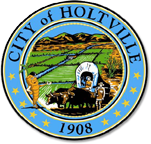Holtville, California
| City of Holtville | ||
|---|---|---|
| City | ||

Holtville City Hall
|
||
|
||
| Motto: "The Carrot Capital of the World" | ||
 Location in Imperial County and the state of California |
||
| Location in the United States | ||
| Coordinates: 32°48′40″N 115°22′49″W / 32.81111°N 115.38028°WCoordinates: 32°48′40″N 115°22′49″W / 32.81111°N 115.38028°W | ||
| Country |
|
|
| State |
|
|
| County | Imperial | |
| Incorporated | July 1, 1908 | |
| Area | ||
| • Total | 1.153 sq mi (2.986 km2) | |
| • Land | 1.148 sq mi (2.974 km2) | |
| • Water | 0.005 sq mi (0.012 km2) 0.40% | |
| Elevation | -10 ft (-3 m) | |
| Population (2010) | ||
| • Total | 5,939 | |
| • Density | 5,200/sq mi (2,000/km2) | |
| Time zone | Pacific (PST) (UTC-8) | |
| • Summer (DST) | PDT (UTC-7) | |
| ZIP code | 92250 | |
| Area codes | 442/760 | |
| FIPS code | 06-34246 | |
| GNIS feature IDs | 1660761, 2410780 | |
| Website | www |
|
Holtville (formerly, Holton) is a city in Imperial County, California. Holtville is located 10.5 miles (17 km) east of El Centro. The population was 5,939 at the 2010 census, up from 5,612 in 2000. It is part of the 'El Centro, California, Metropolitan Statistical Area'.
The city was founded by Swiss-German settlers in the 1880s, who often entered through the border from Mexico. The construction of railroads in the 1890s, the All-American Canal in the late 1940s, U.S. Route 80 in the 1920s later converted to Interstate 8 in the 1970s and the North American Free Trade Agreement (NAFTA) economic boom in the 1990s brought more people to Holtville and the Imperial Valley.
The city of Holtville, which was originally called Holton, was founded in 1903 by W.F. Holt, and incorporated on June 20, 1908. The name was changed to Holtville due to a request by the U. S. Postal Service because the name Holton sounded too much like Colton, (in San Bernardino County), the regional headquarters of the Southern Pacific Railroad at the time. The name honors W.F. Holt, founder of the community.
The city lies on the northeast bank of the Alamo River formed by the floods of 1905-07 when the Colorado River break made the river's course turn west and filled the low-lying depression of water now known as the Salton Sea.
According to the United States Census Bureau, the city has a total area of 1.1 sq mi (2.8 km2), with 1.1 square miles land and 0.40% water.
...
Wikipedia


